
Many stars are not constant
When you go out under a starry sky, the stars seem unchanging, eternal, constant. Occasionally you might see a nova or a supernova – apparently “new” stars – but such events usually last only weeks before fading from view, and they are rare (especially supernovae). Apart from those transient reminders that the universe is restless and constantly changing, the stars in the night sky seem to shine with a steady, unwavering light. But many stars are not constant. Their brightness varies over time. We classify a star as a variable star if its light, as seen from the Earth, changes in brightness, where the star is dimming and then brightening again.
Variable stars aren’t rare or unusual. By the year 2020, astronomers had identified more than 2 million variable stars, mostly in our galaxy. It’s not uncommon for amateur astronomers to make interesting and useful scientific discoveries about variable stars. You might wish to join them!
Most stars have at least some variation in luminosity: our own sun, for example, varies in brightness by a small amount (about 1%) over the course of its 11-year cycle. But unless the fluctuation is large enough to be seen from Earth, the star isn’t classified as variable.

The dramatic recent dimming of Betelgeuse
The changes in brightness of variable stars aren’t generally noticeable to the unaided eye, even if the brightness does change over short timescales (say, hours). To observe most variable stars, one needs to monitor star brightnesses carefully over extended periods of time. But there are examples of stars whose brightness has noticeably faded, over short timescales.
A famous recent example is the red supergiant star Betelgeuse in the constellation Orion the Hunter. Betelgeuse is one of our sky’s brightest stars. It’s a prominent star, in a noticeable constellation, and thus there was a worldwide outcry in the astronomical community, when, in late 2019, Betelgeuse suddenly began to dim. By February 2020, it was only half as bright as before. Betelgeuse is nearing the end of its life. Many are aware that – within the next 100,000 years (soon, from an astronomical perspective) – Betelgeuse might explode as a supernova. Could the dimming be a sign Betelgeuse was about to explode?
Betelgeuse did not explode, and its brightness has now returned to normal. Astronomers note that, as the internal process of stars like Betelgeuse began to change, the star throws off enormous clouds of dark dust. Astronomers believe that such dust clouds dimmed Betelgeuse’s light as seen from the Earth.
Will Betelgeuse fade noticeably again? It might, but it’s not possible to predict exactly when.
Do all variable stars brighten and dim due to obscuring clouds of gas? No. There’s more than one reason for a star to change its brightness, and that’s why it’s helpful to divide variable stars into categories.
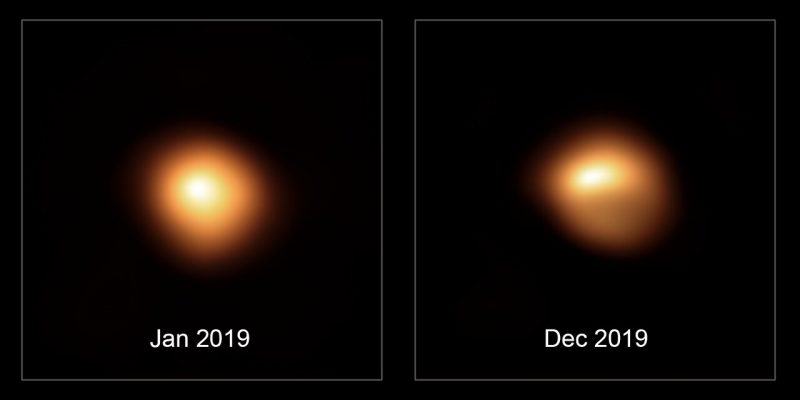
Intrinsic variables, like Cepheids
Intrinsic variable stars are stars whose internal brightness does change, due to events happening within the star itself.
Cepheid variables are the most important of this type. These stars are pulsating variable stars; they literally expand in size and then shrink again, to cause the brightness change. This expanding and shrinking might also cause the star’s shape to become deformed. Cepheid variables are named for the first known example of the type, the star Delta Cephei, discovered to be variable in 1874.
It wasn’t until 1908 that astronomer Henrietta Swan Leavitt discovered a direct relationship between the rate at which Cepheid variables fluctuate in brightness and their luminosities or absolute brightnesses. A street light will appear dimmer as you move farther from it. Likewise, more distant stars appear dimmer than closer stars, assuming both have the same absolute brightness. But if you see a Cepheid variable fluctuating at a certain rate, you know its true brightness and thereby can know its distance.
Cepheid variables are powerful tools in astronomy. They were an early stepping stone in the establishment of the cosmic distance ladder that now enables astronomers to estimate distances to objects hundreds, thousands, millions and billions of light-years away.
Read more about the cosmic distance ladder: Meet Delta Cephei, a famous variable star


Other sorts of intrinsic variables
In addition to the Delta Cepheids, there are approximately 30 sub-groups within the intrinsic variable classification. They differ from one another in the duration of the star’s pulsations, and also its age, type, metallicity and several other factors.
Thus we have RR Lyrae variables, long-period variables and Mira variables. All of them vary due to internal changes within the stars themselves.
Cataclysmic variable stars are also intrinsic variable stars, but have a different cause for their brightness fluctuations. These aren’t single stars getting bigger and then smaller in size. They are two stars, orbiting close to each other: a binary star system. The star whose brightness fluctuates is a white dwarf, an evolved and compact star. The other star is likely to be more ordinary, except for its closeness to the white dwarf. This closeness means that white dwarf’s gravity deforms the shape of the second star, pulling material off it and forming an accretion disk around the white dwarf. This disk often betrays its presence by strong emissions in X-ray and ultraviolet light.
As the accretion disk material falls onto its surface, the white dwarf accumulates material from the second, donor star. Once the amount of material falling onto its surface reaches a critical point, runaway nuclear fusion reactions take place around the star, causing a dramatic brightening of the star, sometimes becoming visible to the unaided eye as a “new” star. Indeed, some single cataclysmic variable events are also called novae, from the Latin word meaning new. Once this conversion has taken place, the fusion reactions end and the star dims to its former brightness.
If enough mass is collected, however, this kind of situation would cause huge thermonuclear explosions that blow the white dwarf apart, destroying it forever, known as a Type Ia supernova.
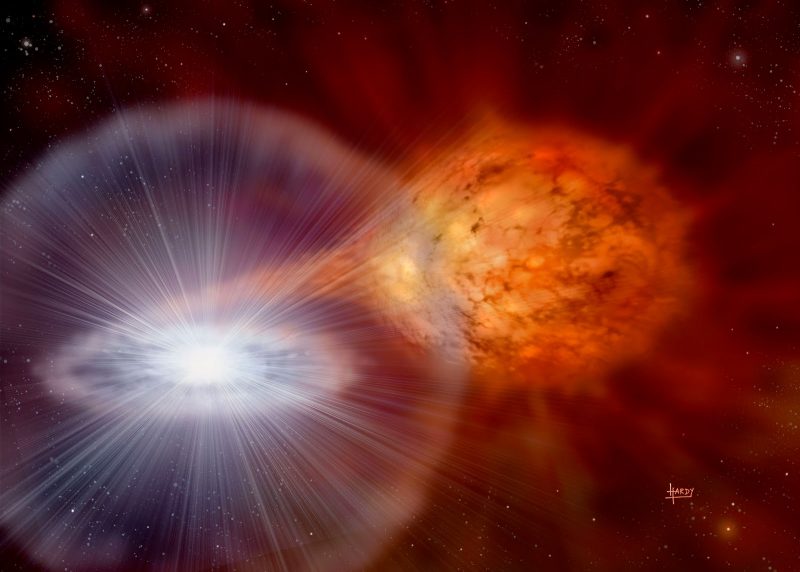
Extrinsic variables
Extrinsic variable stars have brightness fluctuations due to external factors. Again, there are many different types, but they break down into two main groups: eclipsing binaries and rotating variables.
Eclipsing binaries are systems containing two orbiting stars. As seen from the Earth, one star passes in front of the other, causing the eclipsed star’s brightness to fluctuate regularly. A famous example of this type of variable is Algol. Another group of eclipsing variable stars is the W Ursae Majoris variables, where binary stars are situated so close to each other that they whip around each other in less than a day, and the surfaces of the two stars are so close that they are nearly touching!
Rotating variables, on the other hand, are variable stars where the brightness fluctuates due to phenomena associated with their rotation. There are many kinds of rotating variables, for example stars with huge sunspots on their surface which, as these rotate into view of the Earth, block and dim the light from the star.

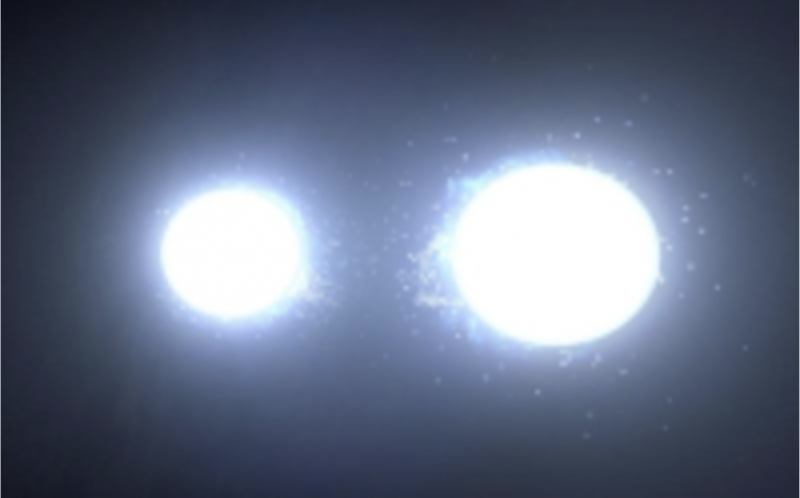
Why study variable stars?
The study of variable stars can reveal much about the nature, history and future of stars. They are extremely varied, classified into groups and subgroups and sub-subgroups. There are many astronomers who specialize in the study of variable stars, and organisations such as the American Association of Variable Star Observers (AAVSO) that serve as collectors and collators of variable star observations.
Observations of variable stars can be carried out by all astronomers, amateur and professional alike. It’s one of the areas of astronomy where sophisticated and expensive technology is not always required to do useful and valuable science. On a base level, all you need is your eyes, although these can of course be augmented with telescopes and equipment to measure the brightness of a star. But all you really need is the ability to estimate the brightness of a star by comparing it to that of others, and this is something that can be acquired with practice if you wish to become a variable-star observer.
Want to observe variable stars? Visit the AAVSO.
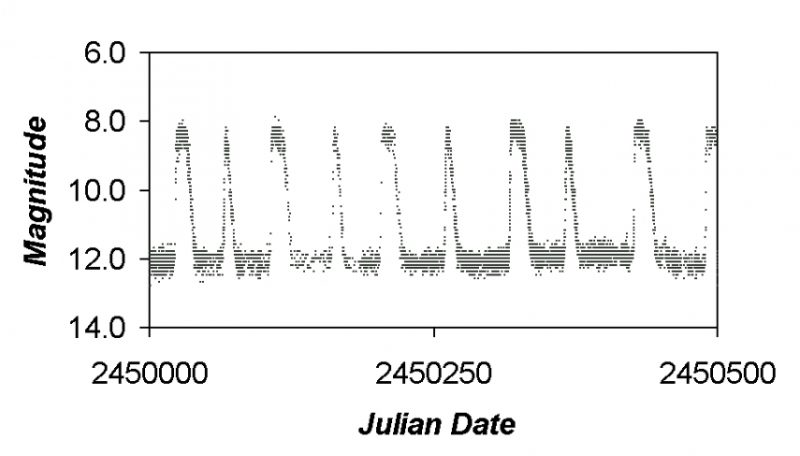
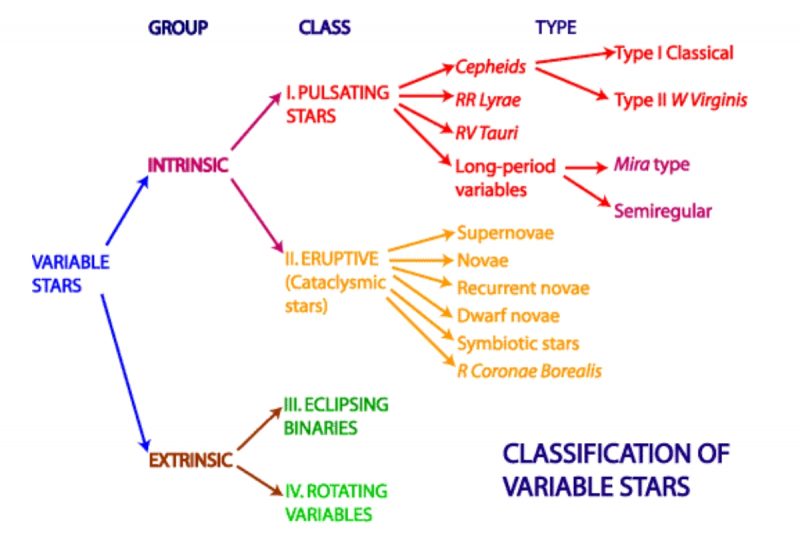
Bottom line: Variable stars are stars whose brightness varies regularly. Their brightnesses may vary in cycles of hours for the shortest ones, to months for the longest ones. Here we discuss the different kinds and what causes the brightness variations.
The post What is a variable star? first appeared on EarthSky.
from EarthSky https://ift.tt/3ga2Yze

Many stars are not constant
When you go out under a starry sky, the stars seem unchanging, eternal, constant. Occasionally you might see a nova or a supernova – apparently “new” stars – but such events usually last only weeks before fading from view, and they are rare (especially supernovae). Apart from those transient reminders that the universe is restless and constantly changing, the stars in the night sky seem to shine with a steady, unwavering light. But many stars are not constant. Their brightness varies over time. We classify a star as a variable star if its light, as seen from the Earth, changes in brightness, where the star is dimming and then brightening again.
Variable stars aren’t rare or unusual. By the year 2020, astronomers had identified more than 2 million variable stars, mostly in our galaxy. It’s not uncommon for amateur astronomers to make interesting and useful scientific discoveries about variable stars. You might wish to join them!
Most stars have at least some variation in luminosity: our own sun, for example, varies in brightness by a small amount (about 1%) over the course of its 11-year cycle. But unless the fluctuation is large enough to be seen from Earth, the star isn’t classified as variable.

The dramatic recent dimming of Betelgeuse
The changes in brightness of variable stars aren’t generally noticeable to the unaided eye, even if the brightness does change over short timescales (say, hours). To observe most variable stars, one needs to monitor star brightnesses carefully over extended periods of time. But there are examples of stars whose brightness has noticeably faded, over short timescales.
A famous recent example is the red supergiant star Betelgeuse in the constellation Orion the Hunter. Betelgeuse is one of our sky’s brightest stars. It’s a prominent star, in a noticeable constellation, and thus there was a worldwide outcry in the astronomical community, when, in late 2019, Betelgeuse suddenly began to dim. By February 2020, it was only half as bright as before. Betelgeuse is nearing the end of its life. Many are aware that – within the next 100,000 years (soon, from an astronomical perspective) – Betelgeuse might explode as a supernova. Could the dimming be a sign Betelgeuse was about to explode?
Betelgeuse did not explode, and its brightness has now returned to normal. Astronomers note that, as the internal process of stars like Betelgeuse began to change, the star throws off enormous clouds of dark dust. Astronomers believe that such dust clouds dimmed Betelgeuse’s light as seen from the Earth.
Will Betelgeuse fade noticeably again? It might, but it’s not possible to predict exactly when.
Do all variable stars brighten and dim due to obscuring clouds of gas? No. There’s more than one reason for a star to change its brightness, and that’s why it’s helpful to divide variable stars into categories.

Intrinsic variables, like Cepheids
Intrinsic variable stars are stars whose internal brightness does change, due to events happening within the star itself.
Cepheid variables are the most important of this type. These stars are pulsating variable stars; they literally expand in size and then shrink again, to cause the brightness change. This expanding and shrinking might also cause the star’s shape to become deformed. Cepheid variables are named for the first known example of the type, the star Delta Cephei, discovered to be variable in 1874.
It wasn’t until 1908 that astronomer Henrietta Swan Leavitt discovered a direct relationship between the rate at which Cepheid variables fluctuate in brightness and their luminosities or absolute brightnesses. A street light will appear dimmer as you move farther from it. Likewise, more distant stars appear dimmer than closer stars, assuming both have the same absolute brightness. But if you see a Cepheid variable fluctuating at a certain rate, you know its true brightness and thereby can know its distance.
Cepheid variables are powerful tools in astronomy. They were an early stepping stone in the establishment of the cosmic distance ladder that now enables astronomers to estimate distances to objects hundreds, thousands, millions and billions of light-years away.
Read more about the cosmic distance ladder: Meet Delta Cephei, a famous variable star


Other sorts of intrinsic variables
In addition to the Delta Cepheids, there are approximately 30 sub-groups within the intrinsic variable classification. They differ from one another in the duration of the star’s pulsations, and also its age, type, metallicity and several other factors.
Thus we have RR Lyrae variables, long-period variables and Mira variables. All of them vary due to internal changes within the stars themselves.
Cataclysmic variable stars are also intrinsic variable stars, but have a different cause for their brightness fluctuations. These aren’t single stars getting bigger and then smaller in size. They are two stars, orbiting close to each other: a binary star system. The star whose brightness fluctuates is a white dwarf, an evolved and compact star. The other star is likely to be more ordinary, except for its closeness to the white dwarf. This closeness means that white dwarf’s gravity deforms the shape of the second star, pulling material off it and forming an accretion disk around the white dwarf. This disk often betrays its presence by strong emissions in X-ray and ultraviolet light.
As the accretion disk material falls onto its surface, the white dwarf accumulates material from the second, donor star. Once the amount of material falling onto its surface reaches a critical point, runaway nuclear fusion reactions take place around the star, causing a dramatic brightening of the star, sometimes becoming visible to the unaided eye as a “new” star. Indeed, some single cataclysmic variable events are also called novae, from the Latin word meaning new. Once this conversion has taken place, the fusion reactions end and the star dims to its former brightness.
If enough mass is collected, however, this kind of situation would cause huge thermonuclear explosions that blow the white dwarf apart, destroying it forever, known as a Type Ia supernova.

Extrinsic variables
Extrinsic variable stars have brightness fluctuations due to external factors. Again, there are many different types, but they break down into two main groups: eclipsing binaries and rotating variables.
Eclipsing binaries are systems containing two orbiting stars. As seen from the Earth, one star passes in front of the other, causing the eclipsed star’s brightness to fluctuate regularly. A famous example of this type of variable is Algol. Another group of eclipsing variable stars is the W Ursae Majoris variables, where binary stars are situated so close to each other that they whip around each other in less than a day, and the surfaces of the two stars are so close that they are nearly touching!
Rotating variables, on the other hand, are variable stars where the brightness fluctuates due to phenomena associated with their rotation. There are many kinds of rotating variables, for example stars with huge sunspots on their surface which, as these rotate into view of the Earth, block and dim the light from the star.


Why study variable stars?
The study of variable stars can reveal much about the nature, history and future of stars. They are extremely varied, classified into groups and subgroups and sub-subgroups. There are many astronomers who specialize in the study of variable stars, and organisations such as the American Association of Variable Star Observers (AAVSO) that serve as collectors and collators of variable star observations.
Observations of variable stars can be carried out by all astronomers, amateur and professional alike. It’s one of the areas of astronomy where sophisticated and expensive technology is not always required to do useful and valuable science. On a base level, all you need is your eyes, although these can of course be augmented with telescopes and equipment to measure the brightness of a star. But all you really need is the ability to estimate the brightness of a star by comparing it to that of others, and this is something that can be acquired with practice if you wish to become a variable-star observer.
Want to observe variable stars? Visit the AAVSO.


Bottom line: Variable stars are stars whose brightness varies regularly. Their brightnesses may vary in cycles of hours for the shortest ones, to months for the longest ones. Here we discuss the different kinds and what causes the brightness variations.
The post What is a variable star? first appeared on EarthSky.
from EarthSky https://ift.tt/3ga2Yze

Aucun commentaire:
Enregistrer un commentaire